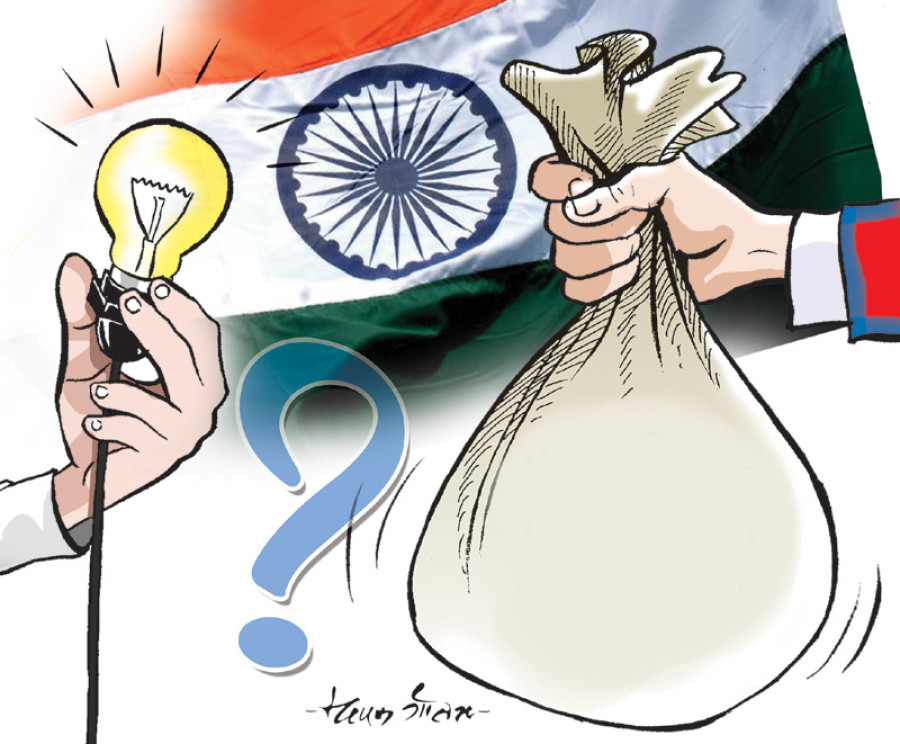Opinion
Purchasing power
India’s new policy affects Nepal’s aspiration to boost growth through hydroelectricity
Bhojraj Poudel
Potential power exporters in Nepal have received a jolt from the new Guidelines on Cross-Border Trade of Electricity released last week by the Indian government. The policy has limited open access to the Indian market for Nepali power producers and foreign investors other than those from India. India’s new policy framework affects Nepal’s aspiration to attain double-digit economic growth through hydropower. The government has planned to develop 10,000 MW including export-oriented and domestic-oriented projects in the next 10 years to fuel economic growth. The question now is whether Nepal can fulfil that aim by developing only domestic-oriented hydropower projects. Yes, it can do so with the right rebalancing policy response to Indian interests in water resources in the region.
India has highlighted that cross-border energy trade involves issues of strategic, national and economic importance in the new guidelines. This is a manifestation of India’s strategic interests in water resources in the region. Blocking unlimited and open access to the Indian power market serves India’s goal of having a stronger say in the utilisation of water resources in the region. Nepali power producers and investors from third countries will be hesitant to invest in Nepal’s hydropower sector due to limited markets. This is what the Nepal government has to focus on.
The new guidelines are against the spirit of the power trade agreement (PTA) signed between Nepal and India in 2015 following Indian Prime Minister Narendra Modi’s visit to Nepal in 2014. The PTA was signed establishing a formidable ground that Nepal would have access to the Indian power market regardless of the nature of the investment in power generation. But now, the guidelines have not only eroded the prospects of hydropower development in Nepal but also hit the spirit of regional power trade in South Asia.
Core of Nepal-India relations
Nepal’s economy is heavily dependent on India from the energy security perspective, and this will become even more complex in the coming days. Hence, the guiding principles of hydropower development in Nepal should be, one, ensuring national energy security and, two, shifting from dependence to independence from the Indian economy. Investment in hydropower development has a direct relationship with Nepal’s resource utilisation and national security. The state should help Nepali investors invest in hydropower development regardless of access to the Indian market. The Nepali private sector has to work in tandem with the government to invest in the energy sector and expand the domestic power market.
The core of Nepal-India relations is water resources. India is interested in Nepal’s water resources. This is not wrong, but what is crucial here is whether Nepal’s leaders will be able to protect the country’s strategic interests while serving Indian interests. India desperately needs water to irrigate vast farmlands in Uttar Pradesh state. The new guidelines complement India’s plan to use water from Nepal for irrigation purposes eventually. Nepal does not win by keeping Indian lands dry, but it will lose if it fails to identify what strategic direction it should take in river-basin management and utilisation of water resources.
Domestic power market
Nepal’s annual peak power demand is estimated at 1,385.3 MW. The Nepal Electricity Authority (NEA) has predicted that the average annual electricity demand will grow by 9 percent and peak demand by 8.85 percent. Currently, the supply of electricity from the integrated national grid amounts to 855 MW, and the shortfall is met by imports from India. Nepal’s economy has faced a power crisis since 2006. It has crippled the country’s industrial growth and slowed the ongoing shift from traditional to commercial sources of energy. In an environment where even the existing industries are not running at full capacity because of power shortages, there is no incentive for new industries to enter the market. Industrial growth remained at an average of 2.1 percent in the last one decade thanks to the energy crisis. There are signs of structural changes in Nepal’s economy—the contribution of the industrial sector is declining while that of the service sector is increasing. The service sector grew at an average of 5 percent in the last decade, but it also suffers from a lack of adequate power.
A sizeable portion of the rural population has not been able to enjoy the benefits of electricity. Only 76.3 percent of the population has access to electricity. Rural households have been denied opportunities to replace traditional fuels for lighting, better schooling, TV, radio and internet, improved health care and access to
information, knowledge and learning. They cannot start home businesses or micro enterprises like milling and drying due to the lack of electricity.
Against this backdrop, there is a potential market for the electricity that is expected to be produced in Nepal. There is, therefore, a strong economic rationale as well as imperative for investing in the power sector to remove the most critical barrier to economic growth and job creation. Supplying adequate and reliable electricity is a national priority and a growth driver that supports the realisation of the national goals of Vision 2030 including Sustainable Development Goals (SDGs).
Pathway for power sector
The pathway would entail basin-wide development of hydropower generation and transmission in a planned way. The investment portfolio has to be an optimal mix of run-of-the-river and storage projects; domestic-oriented projects; hydropower and alternate energy projects; and generation, transmission and distribution projects. But accelerated power development would require a series of reforms and administrative streamlining particularly in the areas of (i) Land acquisition, resettlement and rehabilitation policy, (ii) Environmental (forest) clearance and disaster resilience, (iii) Benefit sharing and local participation, (iv) Project bidding, licensing, project development agreement (PDA) and PDA negotiation framework, (v) Project financing agreement, project financing regulations and sovereign guarantee policy, (vi) PPA, power tariff, wheeling charge and tariff regulation and (vii) Credit worthiness of the NEA, its unbundling, power trading and power market development.
As massive investments will be required to implement the accelerated programme of power development, the investment climate and ease of doing business need to be made favourable and consistent with global business practices to attract sufficient foreign direct investment (FDI) inflows, public resources need to be leveraged to build public-private partnership and financial sector development and reform need to be expedited to mobilise internal resources. The immediate priority in the sector, however, is to remove transmission bottlenecks, reduce system losses and place power trading with India by rebalancing the policy framework, which may require cross-country harmonisation of relevant systems and practices keeping in mind its new approach to cross-border electricity trade.
- Poudel is Economics Officer at the Niti Foundation, a policy research institute




 13.12°C Kathmandu
13.12°C Kathmandu











